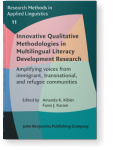Chapter 11
Exploring the ‘void’ of silent/ced knowledge and expertise of multilingual learners
Grounded in a new sociolinguistic, literacy-centered
theory — dialogic void — as a way of exploring
silences in educational spaces, we explored the expressed cultural,
linguistic, and experiential knowledge of 63 multilingual
(Spanish/English) elementary students and the contextual factors
(e.g., scaffolded questioning from discussion facilitators) that may
impact how much knowledge and expertise multilingual students share.
Findings show how the questions and methodological decisions
literacy scholars make, and the ways findings about multilingual
learners in English-dominant classroom contexts are represented can
illuminate otherwise hidden knowledge and expertise. We highlight
how this methodological innovation may be helpful to qualitative
literacy researchers in more deeply exploring their positionality
and ways that disciplinary, cultural, linguistic, and professional
identities can shape (and potentially obscure) observations.
Article outline
- Introduction
- A study of reading discussions with multilingual elementary
students
- Context and participants
- Data sources
- Analytic framework
- Exploring the void
- Positionality
- Exploring contextual conditions
- Findings
- Instances of relevant discursive qualities
- Methodological discussion
- Positionality and the dialogic void
- Positioning young co-learners as knowledgeable others
- Researching moments of silence
- Positionality and graphical (re)presentations
- Positionality and exploration within social space
- Implications
-
Notes
-
References
This content is being prepared for publication; it may be subject to changes.
